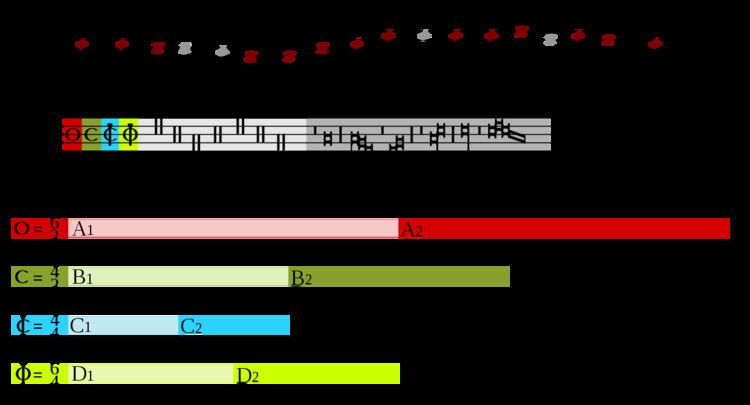 | ||
Nuper Rosarum Flores ("Recently Flowers of Roses/The Rose Blossoms Recently"), is a motet composed by Guillaume Dufay for the 25 March 1436 consecration of the Florence cathedral, on the occasion of the completion of the dome built under the instructions of Filippo Brunelleschi. Technically, the dome itself was not finished until five months later, at which time a separate consecration was celebrated by Benozzo Federighi, the bishop of Fiesole, substituting for the newly appointed archbishop of Florence, Cardinal Vitelleschi (Wright 1994, 396 n2).
Contents
It has been argued that the motet presents homographic tenors and is therefore not an isorhythmic motet as often presented, since there are no isorhythms in its compositional proceedings (Bent 2008,). Regardless, the motet is striking for its synthesis of the older isorhythmic style and the new contrapuntal style that Dufay himself would explore further in the coming decades, as would successors such as Ockeghem and Josquin des Prez.
The title of the piece stems from the name of the cathedral itself: Santa Maria del Fiore, or St. Mary of the Flower. The opening lines of Dufay's text refers to Pope Eugene IV's gift to the cathedral, and to the city of Florence, of a golden rose to decorate the high altar—a gift made the week before the dedication (Wright 1994, 399).
Structure
The two homographic tenors, which define the overall structural plan of the piece, are both based on a Gregorian cantus firmus melody taken from the introit for the consecration of churches, Terribilis est locus iste ('Awesome is this place', Genesis 28:17), a fifth apart and with different, interlocking rhythmic configurations. This double-tenor motet construction, which Dufay had used previously only in Ecclesie militantis in (probably) 1431, became a regular feature of his later motets, though Nuper rosarum flores is the sole example in which the tenor secundus draws on the same plainchant as the tenor primus (Fallows 1987, 46 & 117).
Although the standard modern version of this chant has seventeen notes for the first four words, late medieval chant books such as the ones used in Florence in the early 15th century, have only fourteen notes. These fourteen notes are used as a canonic color in the two tenors, with an interlocking talea pattern (the rhythm patterns of the two tenor parts are different from each other) that totals 28 longa notes, of which the first 14 are rests. This interlocked pair of tenor parts is stated four times, following a diminution scheme in which the identical notation is interpreted under four different mensuration signs, first in tempus perfectum in integer valor (each longa transcribed as a 6/2 bar), then in tempus imperfectum in integer valor (transcribed as 4/2), then in tempus imperfectum diminutum (4/4), and finally in tempus perfectum diminutum (6/4), resulting in total length proportions of 6:4:2:3 (Wright 1994, 397–98). This is unusual for isorhythmic motets, in which the sections normally become progressively shorter, but this proportional structure achieves its own equally effective balance. Moreover, the final isorhythmic section provides the usual drive to an accelerated finish by giving the upper voices the shortest note values in the piece (Fallows 1987, 117–18). Each of the motet's four proportional sections has two sub-sections, suggesting even an eight-part structure. The first of these sub-sections includes just the two upper voices (bicinium), while the second not only is sung by all voices but also features the entry of the two instrumental tenor parts.
This large-scale plan contradicts the poetic structure of the text in the upper voices, which is divided into four strophes of seven lines, each consisting of either seven or eight syllables. The first two strophes describe the event being celebrated: "recently roses bloomed in the bitter cold of winter, adorning the Church; today it will be consecrated by Pope Eugenius with holy hands and oils". The last two strophes run together and are a prayer to the Virgin on behalf of the people of Florence (Carpenter 1973, 5–6).
Controversy
The musicologist Charles Warren claimed that the proportional structure of the motet mimicked the proportions of Santa Maria del Fiore, the cathedral for whose consecration it was composed (Warren 1973). However, David Fallows (1987, 283 n46), Charles Turner (1991, 99–102), and others subsequently cast doubt on Warren's figures. Following these critiques, Craig Wright published a compelling refutation, demonstrating that Warren's analysis "does violence to the architecture of the church", and that the "unique ratio 6:4:2:3, which governs Dufay's motet, is... in no way immanent, or even superficially apparent, in the design of the cathedral of Florence". Instead, he concludes that Dufay's inspiration was the biblical passage 1 Kings 6:1–20, which gives the dimensions of the Temple of Solomon as 60 x 40 x 20 x 30 cubits (Wright 1994, 401, 404–407). Marvin Trachtenberg more recently attempted to rehabilitate Warren's theory, even while conceding that "It is difficult to find fault with Wright's critique, whether regarding his refinement of Warren's musical reading, his own presentation of the textual, Solomonic-Marian syndrome, or his refutation of Warren's architectural analysis" (Trachtenberg 2001, 742).
In 2012, the architect and musician Tiago Simas Freire presented a hypothesis in which none of the figurative relationships previously established between the motet and an architectural object are valid, from both theoretical and practical approaches. This was the result of two Master studies in both Architecture and Ancient Music and presented in NEXUS2012-Milano.
